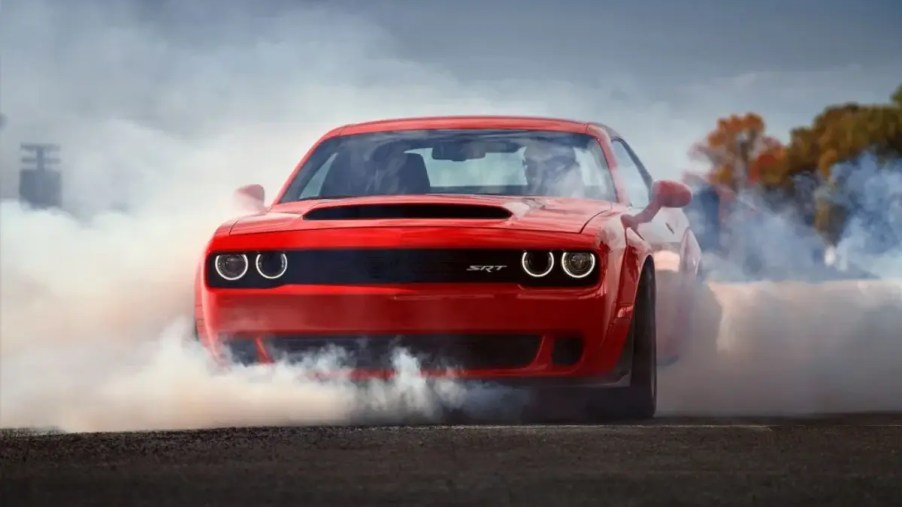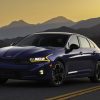
The Top Fastest Muscle Cars of All Time
We’ve seen powerful and iconic muscle cars throughout the decades, like the Ford Mustang and Chevy Camaro. The Dodge Challenger and Dodge Charger were also two of the first muscle cars on the scene, now even brawnier thanks to Hellcat engines. Stellantis is even taking muscle cars into the EV era with the Dodge Muscle.
Speed and athleticism draw enthusiasts to fast cars. But what else makes these vehicles legendary? Here are the top fastest muscle cars of all time.
What is America’s fastest muscle car?
One of America’s most recognizable muscle cars is also among the top fastest muscle cars of all time. The Dodge Challenger SRT Demon comes equipped with a supercharged V8 Hemi that makes a jaw-dropping 840 hp with high-octane racing fuel. That gives it an estimated 0-60 mph time of 2.3 seconds — 0.5 seconds quicker than most rivals.
Using regular fuel results in a loss of a mere 33 hp and a 0-60 mph time of 3.25 seconds. The Challenger Super Stock cost $82,270, so that means not everyone can experience its full potential. Fortunately, the Dodge Challenger has an impressive lineup of other engines for every budget.
The Dodge Challenger R/T is the cheapest model with a Hemi V8, producing 375 hp and reaching 60 mph in 4.8 seconds. Even with the Challenger’s V6 drivers can jump to 60 mph in a respectable 6.3 seconds. Its bulky shape makes it a little less nimble, but its tight suspension results in a thrilling drive across all trims.
What was the most sold muscle car?
Some muscle cars have come and gone, but the Ford Mustang remains on top among the top-fastest muscle cars of all time (in sales, at least). Autotrader reports that 2019 was one of the Mustang’s best years, selling around 72,000 units. Even the pandemic couldn’t hold the Mustang back from success: It sold over 61,000 units in 2020.
That’s impressive for a model approaching 60 years old, especially with so many capable rivals in the segment. Autotrader contributes the Mustang’s success to its varied trim lineup. The 2024 Ford Mustang will start at just $30,920, making it one of the most affordable new sports cars.
Its standard turbo-four engine makes 315 hp. Once Shelby variants are available, we might see horsepower numbers upwards of 800 hp. That should clear 60 mph in about 3.0 seconds. The Ford Mustang also exhibits great handling, with a smoother ride quality than most other muscle cars. So the all-new 2024 version is highly anticipated.
What is the rarest muscle car?
For some drivers, the most desirable muscle cars remain in a bygone era. According to TopSpeed, the 1967 Shelby Cobra Super Snake remains one of the rarest muscle cars in existence. It was based on the AC Ace and S/C Cobra, with a few additions to make it a street-legal V8 monster.
Only two were ever produced, with one reportedly destroyed in an accident. The remaining example has an estimated value of $5 million. A V8 engine and a pair of superchargers allowed it to produce 800 hp and reach a top speed of 200 mph.
The 1967 Shelby Mustang GT500 Super Snake, a ramped-up incarnation of the Ford Mustang, recently sold at auction for $2.2 million. Shelby reportedly wanted to make 50 units of the Super Snake, but Ford deemed the project too expensive. As a result, only one exists.
It packs the same V8 as the Ford GT40 MKII, producing around 485 to 500 hp. It can reach a max speed of 170 hp, though we’re not sure how often it goes for test drives nowadays. Regardless, it’s among the rarest and top-fastest muscle cars of all time.
Which V6 muscle car is the fastest?
The Chevy Camaro might not be as popular as the Ford Mustang, but its V6 engines are unparalleled in their class. According to Chevy, a Camaro packing a standard V6 can reach 60 mph in 5.4 seconds. The 2016 Chevrolet Camaro was a hair quicker, reaching the same speed in 5.1 seconds, Autobytel reports.
The V6 in the 2024 Chevy Camaro, the last year of Camaro production, makes 335 hp and 284 lb-ft of torque. A six-speed manual or 10-speed automatic transmission transfers the power. The V6 and V8 engines benefit from a longer 10-speed automatic gearbox.
Camaro engines provide smoother power delivery overall, even without the engaging six-speed manual. Drivers can also get the 1LE package for fun racing enhancements, including Brembo brakes and electronic power steering. The most powerful Chevy Camaro comes with a supercharged V8 capable of 650 hp.
What was the baddest muscle car ever made?
HiConsumption calls the 1970 Plymouth Barracuda “one of the most celebrated” muscle cars ever created. The two-door pony car was in production for only 10 years, actually arriving before the Ford Mustang. The Barracuda’s final makeover in 1970 proved to be its most popular, giving it some much-deserved cosmetic and mechanical upgrades.
This muscle car was equipped with a 7.0-liter V8 capable of 425 hp and a 0-60 time of 5.6 seconds. It also got a distinctive hood scoop and came in an array of dynamic colors. According to Auto Express, the Plymouth Barracuda was discontinued because it never met the new emissions standards.
1964 Pontiac GTO: The original ’60s muscle car
Auto Express also attributes the popularity of muscle cars to the 1964 Pontiac GTO. It boasted a 6.4-liter V8 harnessing of 348 hp and 428 lb-ft of torque. This huge power upgrade was available only through a performance package, whereas the original Tempest produced only around 140 hp.
Its added muscle allowed it to reach 60 mph in 5.7 seconds. The package also included a four-speed manual transmission, triple carburetors, and a racing-tuned suspension. It cost only $4,000 extra at the time, but now a fully loaded Pontiac GTO can easily go for $50,000 to $60,000.
The 1970 Chevrolet Chevelle SS 454 was a beast
The 1970 Chevy Chevelle SS was rare, with less than 4,500 units released to the public. It was also Chevrolet’s first muscle car, developed as a rival to the legendary Pontiac GTO. The Chevelle SS lived up to its “Super Sport” name with a V8 engine producing 450 hp and 500 lb-ft of torque.
Like most of its competitors, it could reach 60 mph in the lower five-second range. It was also customizable with a cowl-induction hood, racing stripes, and beefier F41 suspensions.
The 1970 Plymouth Road Runner Superbird flew like a bird
With its conical nose and huge rear spoiler, the Plymouth Road Runner Superbird is easily the most distinctive version of the Road Runner. It’s also one of the rarest and most valuable cars to collectors, often valued at hundreds of thousands of dollars. It was developed exclusively as a stock race car, followed by a limited production run of only one year.
NASCAR abandoned this classic car after it implemented new restrictions, and consumers at the time didn’t appreciate the Superbird’s weirdness. Though it was slightly slower than the original Road Runner, the Superbird could still reach 60 mph in 5.5 seconds. It offered three engine choices, the most powerful a Hemi harnessing 425 hp.
The 1967 Chevrolet Camaro Z28 zoomed
The Mustang and Camaro have competed since the ’60s, but the Chevrolet Camaro Z28 was the first serious rival. It was based on the Nova, a two-door coupe that Chevy would later offer as a four-door and a station wagon. However, even the Nova SS couldn’t compare to the Camaro Z28.
It offered a few V8 engines producing between 290 and 375 hp. Chevrolet even produced some examples with a big-block 425-hp V8. The Z28 models sported a four-speed manual transmission and optimized racing suspension. The Chevy Camaro Z28 still lives on, its 2015 model producing 505 hp.
The 1969 Chevrolet Camaro COPO ZL1 was faster than advertised
This is another particularly rare Camaro, with only 69 units made during its lifetime. The 1969 Chevrolet Camaro COPO ZL1 got its name from its ZL1 engine, a 427-cubic inch V8 officially capable of 430 hp. However, the COPO ZL1 consistently reached 500 to 550 hp during unofficial speed tests. It was aided with heavy-duty springs and front brakes, plus a cowl-induction hood.
It could clear 60 mph in less than 5.3 seconds, SuperCars reports. With its stock tires, it reached the quarter-mile in a little over 13 seconds. Twenty models from the original production run, prepped for NHRA Super Stock races, could hit that mark in 10 seconds.
The 1970 Buick Skylark GSX Stage 1 set the stage
Automakers are continually trying to outdo one another with the fastest production car. The 1970 Buick Skylark GSX Stage 1 was one of the first cars to fit that bill, producing 360 hp. It also made 510 lb-ft in torque, a best-in-class spec at the time.
Its powertrain could push it to 60 mph in only 6.2 seconds. However, it cleared that speed in 5.5 seconds during MotorTrend’s testing, HorsePower Memories reports. The Stage 1 models also came with optimized carburetors and a bigger camshaft and valves for the engine.
Like other muscle cars of the era, the 1970 Buick Skylark GSX Stage 1 allowed owners to customize it with bombastic paint options and exterior accessories. Unfortunately, the popularity of the Pontiac GTO and Chevy Chevelle led to an early demise for this Skylark. Models listed on BringATrailer typically go for around $53,000 — not too bad for its age. Buick made fewer than 700, but that’s relatively less obscure than other muscle cars.
The 1969 Dodge Charger Daytona inspired others
The Dodge Charger Daytona was the automaker’s triumphant return to the racing scene following the Charger 500’s death. It was capable of 425 hp and 490 lb-ft of torque, paired with a four-speed manual gearbox. With its big rear spoiler and narrow front end, the 1969 Dodge Charger Daytona had a unique body even by Charger standards.
Although not as dynamic as before, the Dodge Charger Daytona made its spiritual return in 2006. An optional Daytona package gave that Charger a small rear spoiler, a front spoiler, and a mean blacked-out grille. It also sports some fun enhancements, including racing wheels and performance suspension.
The 1970 Ford Mustang Boss 429 lived up to its name
This muscle car strikes an intimidating figure to match its authoritative name. Its specialized NASCAR engine produced 429 hp, while the base Mustang made only 375 hp. The 1970 Ford Mustang Boss 429 also benefited from aluminum intake manifolds and a close-ratio four-speed manual transmission.
Ford planned to produce a mid-engine Boss 429, but it never made it to fruition. Only about 1,359 units were sold, making the Mustang Boss 429 elusive on the used market. Robb Report said the last one sold on eBay saw bids of $170,000.
Update: 6/14/2023


